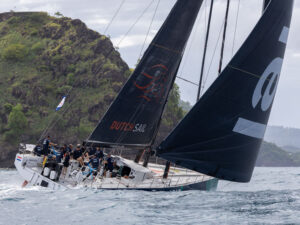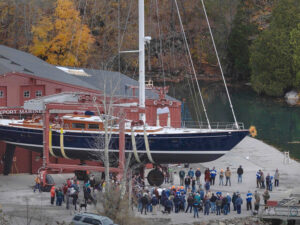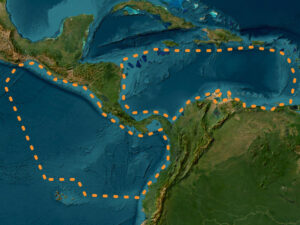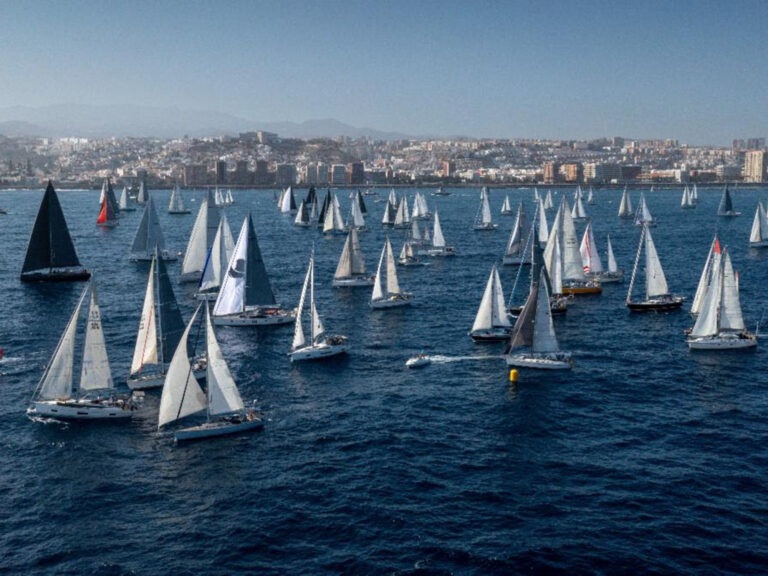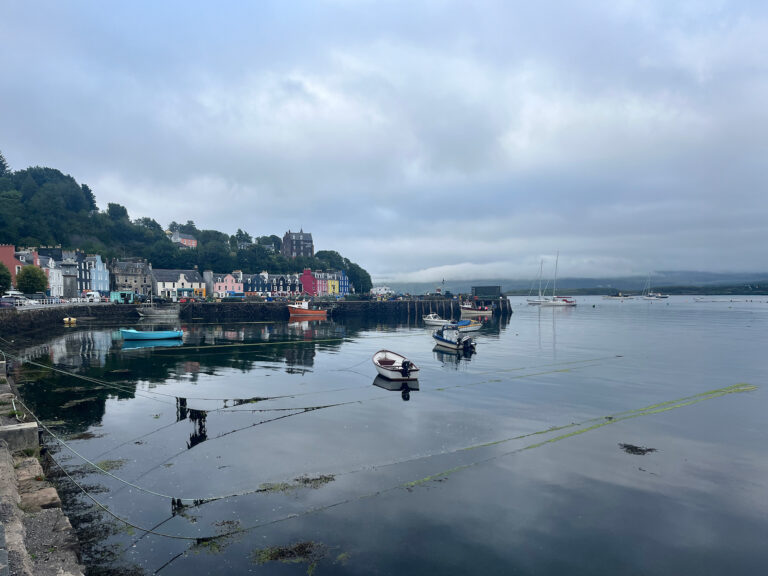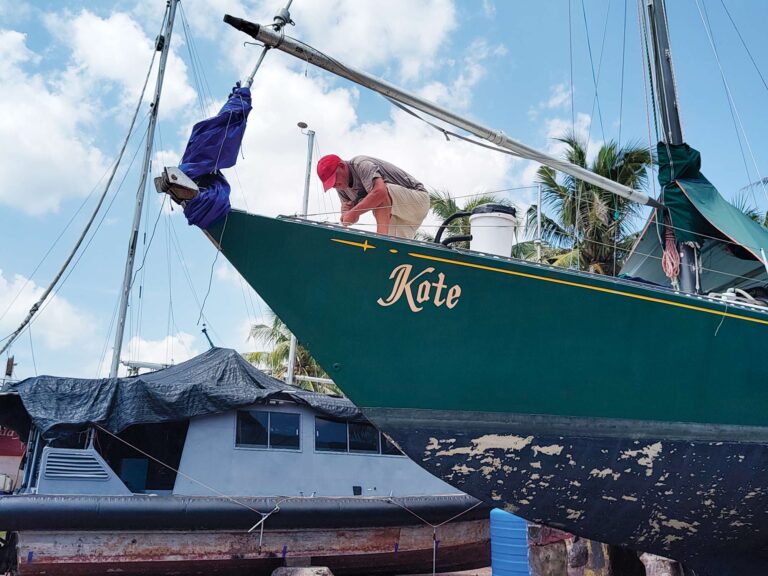
Sprague Family 368
For a hair-raising hour, the fog was so thick I could barely see past the schooner’s graceful bowsprit as we sailed for the windward mark, a rocky ledge in Maine’s Penobscot Bay. It was the 22nd annual Eggemoggin Reach Classic Yacht Regatta, and the wooden boats that loomed suddenly through the fog were some of the most beautiful classic yachts in the world. With mere seconds to alter course, we’d swoop by our opponents with just inches between us and a collision of gorgeous sheer lines, elegant overhangs, and gleaming brightwork. Skippers and crews, many unfamiliar with the conditions, looked tense and pale as ghosts as they disappeared back into the fog; the radio crackled with boats withdrawing from the race. But Lion’s Whelp loped confidently onward, gliding prettily past the rocks under the hand of a skipper, Phineas Sprague Jr., who was as steady as granite.
Phineas was 6 years old when he fell in love with the sea. At his family’s saltwater farm in Cape Elizabeth, Maine, he’d walk a mile through the woods to his first boat, a leaky 16-foot dory. When his godfather returned from sailing across the Pacific bearing gifts of grass skirts and cowrie shells, a dream began to take shape. By the time he was 13, Phin knew what he wanted to do with his life: “Sail around the world. In a schooner. An Alden schooner.”
It’s rare that a childhood dream retains its vitality into adulthood, but for Phin Sprague, his dream first became a young man’s reality, then gained new momentum later in his life, when the ideals and romanticism that informed his boyhood vision were, if anything, stronger and reinforced by decades of experience. So Phin has lain out plans to sail around the world again-in an Alden schooner, of course.
There is a mythology in sailing, Phin says, that one learns “coming up through the hawsepipe; things you recognize as truths and you really don’t understand why or how.” For Phin, long-keel schooners still represent the best in sailing. Created without regard for ratings systems, which distort yacht designs to conform to specific rules, they were developed to be relatively fast, seakindly, comfortable, easy for a few people to handle, and able to sail well in harsh conditions.
While conceding that the long-keelers aren’t as fast as modern designs, Phin feels the tradeoff in comfort at sea is worth the loss of a knot or two of boat speed. There’s also nothing so beautiful to his eye as the long, elegant lines of a schooner drawn by the designers at John G. Alden, Naval Architects. “You sail anything you can get your hands on, but in the final analysis, you want to have something you love to look at. Life is too short to own an ugly boat,” Phin says.
In 1972, the 22-year-old Phin and two school friends bought an aging 72-foot John Alden/Aage Nielsen-designed wooden schooner, Mariah. The delivery home to Maine from City Island, New York, may have marked the first dampening of his partners’ enthusiasm for cruising. Mariah was an old, leaking, barebones boat without winches or electronics, and they set sail on December 16 into the teeth of a building gale. With no heat, a damaged engine, and rough weather, it wasn’t the romantic adventure that the friends envisioned.
A year later, Mariah and her young crew left Newport, Rhode Island, in December to sail around the world. They soon found themselves being blown offshore, overcanvassed, in 45 knots. Sailing too fast, Mariah dropped off a wave; the resulting leaks were bad enough to necessitate hauling her out in Florida. They found nine broken planks and five broken frames, and a month of sweaty boatyard work further eroded the crew’s enthusiasm. Still, it wasn’t all bad. They visited some Florida beaches, where Phin met a young Canadian nurse named Joanna.
Mariah continued to test her crew’s commitment as they sailed south into the Caribbean. After long passages highlighted by water spouts, very physical sailing, and constant maintenance, they made their first celestial-navigation landfall in Panama and limped into port with a failing engine. Here it was that Phin’s disillusioned friends stepped ashore and left Mariah for good, but Phin was as happy as he’d ever been. A Yankee embodying the old New England values of inventiveness, cheerful industry, and self-reliance, Phin found the challenges and the serious responsibility to be fulfilling. He was going to sail this schooner around the world, but he needed more crew. He collected a few sailors in Panama, called his brother Seth to join him, and placed a long-distance call to Joanna, the girl he’d known for only a few weeks in Florida. Then Mariah set sail for the Galápagos.
For the next two years, Phin and Joanna, along with Phin’s brothers, sister, and various friends, explored the Pacific in the spartan cruising style of the day. In 1975, Phin’s and Joanna’s families joined them in Bali for the holidays-and a surprise. At Christmas dinner, as Joanna’s dad began carving the roast pig, the local minister began an impromptu wedding ceremony. Phin and Joanna were married on deck, under the swaying palms.
Mariah returned home to Maine in 1977, and an account of the voyage was published in Cruising World that June. (See “Voyage of Mariah,” Shoreline.) Author Betsy Hitz closed her story with these lines: “Joanna and Phin, now 23 and 26, plan to live ashore for a few years. . . . Mariah is for sale, but Phin assured me, ‘There will be another boat!'”
For the next two decades, as they raised their family and developed their Portland, Maine, boatyard, Portland Yacht Services, Phin and Joanna always had an eye out for a replacement for Mariah. They considered many of the very boats that have contributed to the fame and allure of Alden schooners, including Vela, When and If, Malabar X, and Tar Baby. But none of these grand dames seemed up to the task of circumnavigating.
Then one day, Phin stumbled upon an ad: “65-foot Alden schooner hull, strip-plank cold-molded, unfinished. San Diego.” This was exciting: What if they could build the exact boat that they desired? After all, they had a boatyard. But building a 65-foot schooner to Phin’s exacting standards would require a lot of capital; a partner would be needed. Phin’s brother, Abbot, had practically grown up sailing during the first circumnavigation. He wanted to get his own kids involved in cruising, but after his early experiences sailing the demanding Mariah, he had no interest in old schooners. A new boat, on the other hand, was an entirely different proposition.
The two brothers met in San Diego and went to look at the Alden, which was high and dry beside a California freeway. The relentless sun had burned the decks and disintegrated the plastic tarps that once covered the hull, and there was visible rot from a decade of standing water inside. Despite the damage, though, the boat’s lines and potential spoke to them, and she was soon on her way across the country back to Maine. Says Phin, “I felt whole again. Ignoring the work of several years that lay ahead, I had my hands on a boat! A boat!”
Abbot and Phineas Sprague’s ancestors were Pilgrims, having arrived in New England in 1629 aboard a ship named Lion’s Whelp. Subsequent generations of Spragues built a series of pleasure boats that shared the same name. Since the new schooner was to be a family project and would one day carry family members to the far reaches of the world’s oceans, it seemed only fitting that she be christened Lion’s Whelp.
The hull had a year to dry out indoors while Phin concentrated on the design. Niels Helleberg, the boat’s original designer at Alden, worked with him on the layout, deck, and rig. It was clearly an enjoyable experience for both men. Niels calls Phin “an extremely knowledgeable yachtsman with years of experience.” The designer was impressed that the project wasn’t rushed: They took the time to get every detail exactly right, and it shows, he says, in the finished product. Phin was meticulous about researching options, and after concluding his work with Niels, he designed the interior details and systems installations himself. The result is an intriguing marriage of old and new technologies. The masts, for example, are of carbon fiber painted to look like varnished spruce. Having lost parts of Mariah’s rig, Phin wanted beefy masts that would be both strong and flexible. While the sails are still raised using multipart tackle (not winches) and made fast to traditional belaying pins, the halyards are high-tech cordage.
When Portland Yacht Service’s crew examined the hull, they found that it was in worse shape than they’d expected. Standing rainwater had ruined wooden floor frames and disintegrated mahogany plywood. Sounding the cold-molded outer hull revealed pockets of rot. In the end, the floors, the frames, the lower parts of the ribs, and all of the strip planking for a foot and a half above the keel were removed and replaced. After the interior had been epoxy-coated and vacuum-bagged, new floor frames, mast steps, and engine mounts were constructed of stainless steel. Between the ribs, Nida-Core was used to insulate the hull and to provide rigidity.
In order to test the livability of Phin’s interior design, a full-scale mock-up was constructed of cheap plywood. The builder invited experienced voyaging sailors inside the galley and cabin mock-ups to perform the actions that they’d find themselves typically doing at sea. Their feedback? Phin’s instincts were right, and only a few minor changes were made before the finish work began.
Meanwhile, the cockpit was being constructed off-site by the woodworkers at French & Webb, just up the coast in Belfast. When the boat’s interior and decks were in place, the entire finished cockpit was hoisted up by crane and carefully rolled into place. Every bolt hole lined up perfectly, mute testament to the phenomenal craftsmanship at the Belfast shop.
Lion’s Whelp is an elegant yacht with a stunning mahogany-paneled salon, yet she’s truly a voyager first and foremost. There are no centerline queen berths, so de rigueur on modern yachts; in fact, there’s only one true double berth, and it converts to a single sea berth when under way. Whelp’s layout is comfortable but eminently seaworthy.
Forward is a huge sail locker finished to sleeping-cabin standards and including two single berths; if the bunks are needed for visitors in port, the schooner’s extensive sail inventory will be stowed on deck. Aft is a head with a separate shower and the boat’s sleeping cabin, with twin berths to port and a double and single to starboard. A sliding mahogany partition divides the cabin in two for more privacy, and a large butterfly hatch provides ventilation and light, adding to the feeling of openness for the crew.
Although elegantly finished, the main saloon is designed for family cruising and is full of well-conceived details. The port seatback, for example, folds to horizontal to become an extra sea berth; folded vertical, it becomes a wide screen for the projection DVD player installed in a paneled cabinet opposite. Phin recalls a stormy passage to Bermuda recently when he was struggling with the staysail while alone on deck. He looked down through the butterfly hatch and saw the rest of the crew-his children, brothers, nieces, and nephews-snuggled up watching Finding Nemo in the cozy cabin below.
From the saloon, you step up to the galley, nav station, small dinette, head, and a large quarter berth at the base of the companionway. This area is clearly designed for passagemaking, with strong, intuitively placed handholds and everything the on watch needs within arm’s reach. Lion’s Whelp has a true sea galley, enclosing the cook on three sides, with such thoughtful bluewater details as deep fiddles, a dedicated dish-draining area, and secure pantry storage. The freezer and refrigerator hold more than enough food for several months of cruising off the grid.
The boat’s myriad systems are meticulously installed and hidden behind elegant cabinetry. As Joanna says, “Phin put 10 pounds in a five-pound sack.”
There was considerable fanfare with three generations of the Sprague family on hand for the launch of Lion’s Whelp on July 18, 2003. Phin Sprague Sr., a.k.a. Grampa Sprague, gave the toast: “We hope that this newest Lion’s Whelp will safely carry her crew to their desired destinations, as did all of those boats bearing that name, starting with our ancestral ship, which brought our family to America in 1629, and followed by many namesakes. She will be carrying treasured friends and those whom we hold most dear, our family, some seasoned sailors, and many youthful sailors.”
Since her launch, Lion’s Whelp has carried friends and family many miles, mostly from Maine to Bermuda to Antigua and back; she participates in classic-yacht regattas both north and south. She was conceived as the vessel to carry various assemblages of Sprague family members on an ongoing circumnavigation, and the new generation of crew is learning the ropes during spring breaks and summer vacations.
At last year’s Eggemoggin Reach Classic Yacht Regatta, I was fortunate to sail with several members of the family: Phin and his son, Eric, manned the helm and navigated; Abbot and his daughter, Coco, managed the foredeck crew. As Lion’s Whelp ghosted majestically out of the mist into the sunshine on the homeward leg, Abbot strolled aft singing a rollicking sea chantey. Phin and Eric joined in heartily, and the three of them, dripping with fog and grinning ear to ear, sang out: A capital ship for an ocean trip / Was the Walloping Window Blind! / No gale that blew dismayed her crew / Or troubled the captain’s mind. / So blow, ye winds, heigh-ho! / A-roving I will go!
This must be, I thought to myself, just what 13-year-old Phin had been dreaming of those many years ago.
Stacey Collins lives in South Portland, Maine. Her previous Yacht Style feature for Cruising World won a first-place award from Boating Writers International in 2007.

